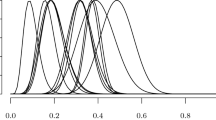Abstract
In dealing with intrinsically imprecise-valued magnitudes, a common rating scale type is the natural language-based Likert. Along the last decades, fuzzy scales (more concretely, fuzzy linguistic scales/variables and fuzzy ratig scales) have also been considered for rating values of these magnitudes. A comparative descriptive analysis focussed on the variability/dispersion associated with the magnitude depending on the considered rating scale is performed in this study. Fuzzy rating responses are simulated and associated with Likert responses by means of a ‘Likertization’ criterion. Then, each ‘Likertized’ datum is encoded by means of a fuzzy linguistic scale. In this way, with the responses available in the three scales, the value of the different dispersion estimators is calculated and compared among the scales.
Access this chapter
Tax calculation will be finalised at checkout
Purchases are for personal use only
Similar content being viewed by others
References
Diamond, P., Kloeden, P.: Metric spaces of fuzzy sets. Fuzzy Sets Syst. 35, 241–249 (1990)
De la Rosa de Sáa, S., Lubiano, S., Sinova, S., Filzmoser, P.: Robust scale estimators for fuzzy data. Adv. Data Anal. Classif. 11, 731–758 (2017)
Gil, M.A., Lubiano, M.A., De la Rosa de Sáa, S., Sinova, B.: Analyzing data from a fuzzy rating scale-based questionnaire: a case study. Psicothema 27, 182–191 (2015)
Herrera, F., Herrera-Viedma, E., Martínez, L.: A fuzzy linguistic methodology to deal with unbalanced linguistic term sets. IEEE Trans. Fuzzy Syst. 16(2), 354–370 (2008)
Hesketh, T., Pryor, R., Hesketh, B.: An application of a computerized fuzzy graphic rating scale to the psychological measurement of individual differences. Int. J. Man-Mach. Stud. 29, 21–35 (1988)
Lubiano, M.A., De la Rosa de Sáa, S., Montenegro, M., Sinova, B., Gil, M.A.: Descriptive analysis of responses to items in questionnaires. Why not using a fuzzy rating scale? Inf. Sci. 360, 131–148 (2016)
Lubiano, M.A., Montenegro, M., Sinova, B., De la Rosa de Sáa, S., Gil, M.A.: Hypothesis testing for means in connection with fuzzy rating scale-based data: algorithms and applications. Eur. J. Oper. Res. 251, 918–929 (2016)
Lubiano, M.A., Salas, A., Gil, M.A.: A hypothesis testing-based discussion on the sensitivity of means of fuzzy data with respect to data shape. Fuzzy Sets Syst. 328, 54–69 (2017)
Puri, M.L., Ralescu, D.A.: Fuzzy random variables. J. Math. Anal. Appl. 114, 409–422 (1986)
Sinova, B., Gil, M.A., Colubi, A., Van Aelst, S.: The median of a random fuzzy number. The 1-norm distance approach. Fuzzy Sets Syst. 200, 99–115 (2012)
Acknowledgements
The research is this paper has been partially supported by the Spanish Ministry of Economy, Industry and Competitiveness Grant MTM2015-63971-P. Its support is gratefully acknowledged.
Author information
Authors and Affiliations
Corresponding author
Editor information
Editors and Affiliations
Rights and permissions
Copyright information
© 2019 Springer Nature Switzerland AG
About this paper
Cite this paper
Arellano, I., Sinova, B., de la Rosa de Sáa, S., Lubiano, M.A., Gil, M.Á. (2019). Descriptive Comparison of the Rating Scales Through Different Scale Estimates: Simulation-Based Analysis. In: Destercke, S., Denoeux, T., Gil, M., Grzegorzewski, P., Hryniewicz, O. (eds) Uncertainty Modelling in Data Science. SMPS 2018. Advances in Intelligent Systems and Computing, vol 832. Springer, Cham. https://doi.org/10.1007/978-3-319-97547-4_2
Download citation
DOI: https://doi.org/10.1007/978-3-319-97547-4_2
Published:
Publisher Name: Springer, Cham
Print ISBN: 978-3-319-97546-7
Online ISBN: 978-3-319-97547-4
eBook Packages: Intelligent Technologies and RoboticsIntelligent Technologies and Robotics (R0)




